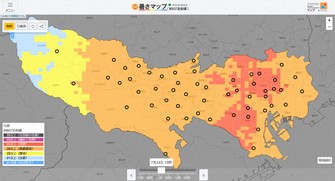
This screenshot shows the “Tokyo heat map” launched by the Tokyo Metropolitan Government.
TOKYO — As part of its heatstroke prevention efforts, the Tokyo Metropolitan Government has launched the “Tokyo heat map” in collaboration with the Japan Weather Association.
The map divides the capital into 1-square-kilometer sections and displays the “heat index” for each area, aiming to provide residents and visitors with detailed data to help avoid heatstroke.
The heat index is a value calculated from the temperature, humidity and “radiant heat” from surfaces such as roads and building walls. The higher the value, the greater the risk of heatstroke.
The map allows users to view hourly changes in the heat index up to 48 hours in advance, as well as the highest values for the coming week. The risk of heatstroke is categorized into seven levels, from “generally safe” (below 21) to “disaster-level danger” (35 and above), and is color-coded. Especially at “danger” (31 and above, red) and higher, the risk of heatstroke is significantly increased, and the map is intended to help people adjust their plans accordingly.
Additionally, the metropolitan government has published a map of “designated cooling shelters” equipped with air conditioning, as it did last year. When a “special heatstroke alert” is issued, municipalities are required by the Climate Change Adaptation Act to open these shelters to the public. There are about 1,800 such locations in Tokyo, including the Tokyo Metropolitan Government Building in Shinjuku Ward and Tokyo Tower in Minato Ward, but awareness about the shelters has been limited.
The metropolitan government has also created a search system for “Tokyo cool share spots,” which allows people to find places to cool off regardless of whether a heatstroke alert is in effect. There are about 1,980 such spots in the capital.
According to the Tokyo Fire Department, 7,996 people were transported to hospitals due to heatstroke in the capital between June and September 2024, an increase of 884 from the same period the previous year, and the number tends to rise annually.
At a regular press conference July 18, Tokyo Gov. Yuriko Koike urged people to “hydrate frequently, use air conditioning without hesitation, and use parasols and hats when going outside.” She added, “We have set up cooling shelters in various locations, so please make use of them. I ask everyone to take sufficient precautions against the heat based on these measures.”
The heat map is available at https://micos-sc.jwa.or.jp/tokyo-wbgt/ (in Japanese only.)
(Japanese original by Ryo Endo, Tokyo City News Department)


AloJapan.com